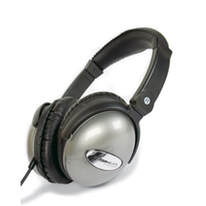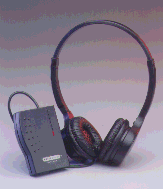
Noise Reduction Headphones 101: (ANR Headphones, Noise Cancellation Headphones)
Whatever you want to call them, ANR headphones have been around since the early 90's. ANR refers to “Active Noise Reduction,” (as opposed to Passive Noise Reduction which is just blocking sound with a bulky, closed headphone, or use of earplugs in the ear canal). If you’re in an environment with a steady, low droning sound, (like an airplane engine), ANR headphones can be helpful because they produce an opposite sound wave to the ear which in effect, lessens the loudness of the offending droning noise. The result, the offending noise is reduced and you now have the means to listen to music or movies through headphones at a normal volume, (FYI, turning up volume in headphones to drown outside sounds is not good for the ears).
Whatever you want to call them, ANR headphones have been around since the early 90's. ANR refers to “Active Noise Reduction,” (as opposed to Passive Noise Reduction which is just blocking sound with a bulky, closed headphone, or use of earplugs in the ear canal). If you’re in an environment with a steady, low droning sound, (like an airplane engine), ANR headphones can be helpful because they produce an opposite sound wave to the ear which in effect, lessens the loudness of the offending droning noise. The result, the offending noise is reduced and you now have the means to listen to music or movies through headphones at a normal volume, (FYI, turning up volume in headphones to drown outside sounds is not good for the ears).
Active Noise Reduction - ANR circuitry only works on one steady, droning noise, like an airplane engine. Random noises like baby's crying or other miscellaneous noises are not affected by the ANR circuitry. For those random noises, you need to have a headphone that is "Closed" in design, (btw, most ANR headphones are closed). FYI, if your location of use doesn't have an offending steady droning noise, you might be wasting your money on ANR headphones. Simple "Closed" headphones cost less and usually have better sound quality.
Sound Quality - ANR headphones costing $300 or more for the most part do offer better sound quality than ANR headphones costing under $100. But, we often get asked if one of those $300 ANR headphones from that self boastful, highly marketed company sound so good that they can use the same headphone for both traveling and for home use? The quick answer is "No," not even close! To an audiophile, an ANR headphone regardless of cost, doesn't sound as good an "Open" headphone designed for use in a quiet environment, (like at home). To get to the point, even a $69 Grado SR60e or a $99 Grado SR80e sounds better to an audiophile than most ANR Headphones! The open Grado offers a detailed sound that is more natural than a closed headphone can offer. We like to emphasize, only a person who does virtually all of their listening in a noisy environment like an airplane, should consider purchasing a $300 ANR headphone! The rest of us can purchase a less expensive ANR headphone for the times that we travel, then use the saved money to purchase a good "Open" headphone for use at home.
Hiss and Dizziness - Another reason ANR headphones don't sound as good as standard headphones is the ANR circuitry introduces a "Hiss" sound. Some are better than others and not all that noticeable, but this is part of the ANR process. We should also mention, there are some who feel the ANR affects them negatively. Some complain of light headedness or dizziness? This reviewer has no such issues, but my spouse does mention it affects her some?
In-Ears - While we're not going to tackle this subject in this article, we thought we would mention some people prefer to use in-ear, earphones rather than ANR headphones. Good fitting in-ears, (sitting deep in the ear canal), can block out noise quite effectively. The plus is they have evolved to where some sound pretty good and they are naturally super portable. The negative is many people can't get used to sticking the things deep into their ear canal and just can't get comfortable with them. And BTW, some companies offer in-ears with ANR circuitry. To us, this is just not needed. A good in-ear with a good seal in the ear canal does not need ANR circuitry as all outside noises are naturally blocked! A Note About In-Ear Sound: The sound of In Ears is very much an "In the head" thing. The transducers are literally right next to your ear drums. Many people find they like the "In your head" sound that results, but some of you may not. Just depends! Some of you may prefer the standard headphone sound which comes at your ears from a little bit further away.
Sound Quality - ANR headphones costing $300 or more for the most part do offer better sound quality than ANR headphones costing under $100. But, we often get asked if one of those $300 ANR headphones from that self boastful, highly marketed company sound so good that they can use the same headphone for both traveling and for home use? The quick answer is "No," not even close! To an audiophile, an ANR headphone regardless of cost, doesn't sound as good an "Open" headphone designed for use in a quiet environment, (like at home). To get to the point, even a $69 Grado SR60e or a $99 Grado SR80e sounds better to an audiophile than most ANR Headphones! The open Grado offers a detailed sound that is more natural than a closed headphone can offer. We like to emphasize, only a person who does virtually all of their listening in a noisy environment like an airplane, should consider purchasing a $300 ANR headphone! The rest of us can purchase a less expensive ANR headphone for the times that we travel, then use the saved money to purchase a good "Open" headphone for use at home.
Hiss and Dizziness - Another reason ANR headphones don't sound as good as standard headphones is the ANR circuitry introduces a "Hiss" sound. Some are better than others and not all that noticeable, but this is part of the ANR process. We should also mention, there are some who feel the ANR affects them negatively. Some complain of light headedness or dizziness? This reviewer has no such issues, but my spouse does mention it affects her some?
In-Ears - While we're not going to tackle this subject in this article, we thought we would mention some people prefer to use in-ear, earphones rather than ANR headphones. Good fitting in-ears, (sitting deep in the ear canal), can block out noise quite effectively. The plus is they have evolved to where some sound pretty good and they are naturally super portable. The negative is many people can't get used to sticking the things deep into their ear canal and just can't get comfortable with them. And BTW, some companies offer in-ears with ANR circuitry. To us, this is just not needed. A good in-ear with a good seal in the ear canal does not need ANR circuitry as all outside noises are naturally blocked! A Note About In-Ear Sound: The sound of In Ears is very much an "In the head" thing. The transducers are literally right next to your ear drums. Many people find they like the "In your head" sound that results, but some of you may not. Just depends! Some of you may prefer the standard headphone sound which comes at your ears from a little bit further away.

For years Listening Station, (GoodCans.com), stocked and sold the “Noisebuster” headphones from NCT, (Do you remember the ads in the catalogs from the seat pockets in front of you on Airplanes?). They originally sold for $70. The Noisebusters didn’t have all that great of sound quality. But Noise Reduction wise, they were as good or better than many of the ANR headphones currently sold. These days, there are better choices. In fact, we did a quick search and found the following affordable ANR headphone at Amazon is quite popular...

